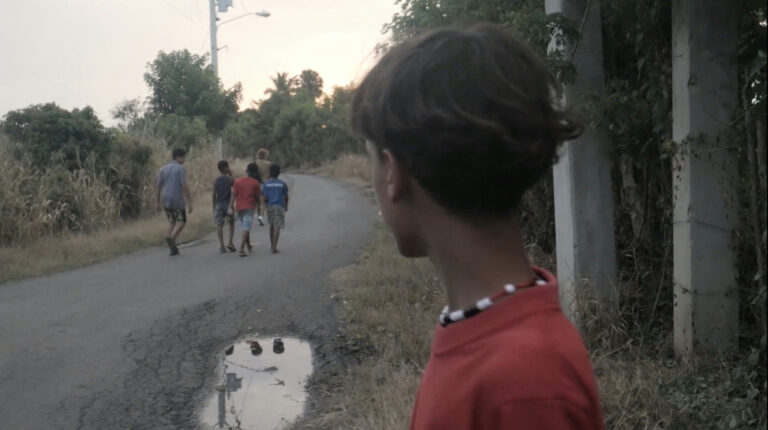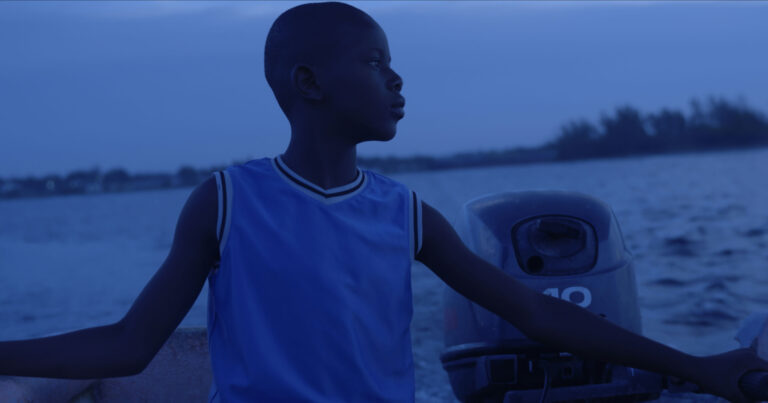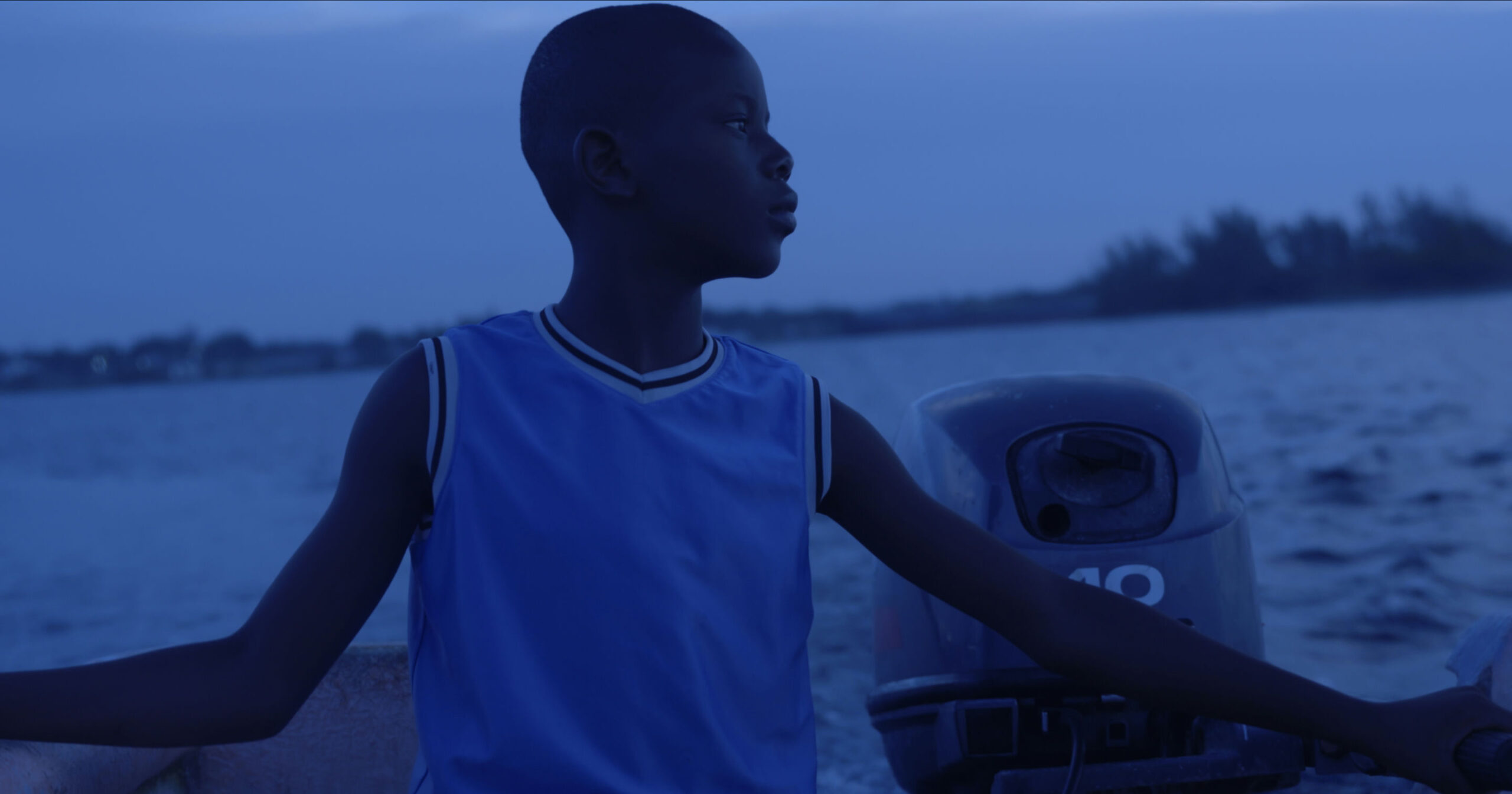ON THE OTHER ISLAND: New Films and New Visions from the Dominican Republic was a Shorts Program from the 45th Hawai‘i International Film Festival presented by Halekulani
The 2025 HOCCI Cohort Reviews Three Films From ON THE OTHER ISLAND: New Films and New Visions from the Dominican Republic
At HIFF45, the short film program ON THE OTHER ISLAND: New Films and New Visions from the Dominican Republic was one of three assigned screenings that the 2025 HOCCI cohort attended together, and one particularly memorable for its connections to Hawai‘i. The program, curated by Julia Scrive-Loyer and Diego Cepeda, included eight short films, most directed by young student filmmakers and produced at universities, offering experimental and liberatory visions of the Dominican Republic. The screening was followed by a conversation hosted by HOCCI mentor Emerson Goo. Our cohort was most excited to discuss Alexander Vasquez’s CAMINO DE VUELTA (2024), Ricardo Ariel Toribio’s DIABLO (2025), and Pamela Bencosme’s DEPEYIZÉ (2024), three films about the freedom provided by imagination, whether that of children, festival goers, or family members. These films ask us to imagine the possibilities of cinema in our islands.

D’Elle Martin
A bike tire is spinning. It rolls forward along a dirt path. It is guided by a stick and a cut piece of plastic from a milk carton handle. Children are playing in the distance, yelling, “The cow named Lola! The cow named Lola!” The stick and the tire fall to the ground, and a young boy runs into a banana patch nearby.
Vásquez draws in viewers by reminiscing memories of youth. CAMINO DE VUELTA, or “on the way back,” follows a boy on Christmas Day who avoids going home. Scenes shift from first to third person, weaving a narrative that lets you experience both the thrill and the peace of the company of others. It starts with running through banana trees—leaves whipping past your face—to passively observing from a distance, watching seven boys sit together, playing video games in silent concentration. Moments like these, ranging from wild laughter to quiet comfort, build a feeling of satisfaction until the boy gets closer to home.
After spending the entire day outside, the boy finally makes it home before dark. He enters the house quietly, goes into a room full of stuffed colorful plastic shopping bags, and comes back out with some Christmas lights. He goes into the living room, plugs it into an outlet, and starts untangling the lights. His mother walks over and unplugs them. He sits for a moment in silence. He does not say anything, just looks down at his hands. Another boy comes in to ask permission from the mom to let her son come out and play with them. The mother does not answer but gets up to leave, and then the son goes outside to play with the other boys, drawing shapes into the night with sparklers.
This scene stood out to me because anyone who has grown up in a household with overworked parents knows that look of exhaustion. The look that tells you as a child, “it is not the time to play,” but the time to be quiet and listen. Inside, silence sticks to the built environment, but outside, you can always be a kid. CAMINO DE VUELTA shows the reminiscence of childhood, but also reminds us of the power of silence.
Abdul-Rahman Sakr
The film opens with a beautiful shot of a young boy’s hand pushing a basic toy made from a stick and a loose bicycle wheel. The boy skillfully balances the wheel as it speeds up. This shot sums up the film’s theme remarkably well. As simple as it looks, it made me realize this wasn’t going to be an average short. By not showing the character’s face, the filmmaker establishes that the film is not just a certain character’s journey but an exploration of the universal theme of a child seeking happiness and joy.
We quickly transition to an innocent but mischievous boy who jumps into a game of tag around banana trees with his friends. The frantic shots quickly made me motion sick, but my eyes were glued to the screen. The rapid movements and laughter of the kids were so lively and pure. The film abruptly cuts to a group shot of the kids sitting down playing video games on their phones and iPads. The contrast between this static shot of the kids using technology and the handheld shots of the physically demanding game they played earlier was striking. The lack of camera movement conveyed how static life in the digital world is.
Slowly the boys are called home one after another by their parents, and one boy takes his eyes off his phone as he watches the others leave. In this shot I felt a sense of grief building up within him, but it wasn’t until the next shot that I understood why. In a masterful close up of the boy with his friends in the background he turns and asks if they want to stay and play. But they can’t; they have to go home to shower and eat. His friends walk away from him. The camera stays on the boy’s face as he lingers, hoping for someone to join him, but no one does.
A Nolan-esque tracking shot then follows the boy from behind as he walks home. The environment gets darker and darker. Inside, the boy is alone. The shooting style shifts again to more traditional shot reverse shot approach. We don’t fully understand the dynamic between him and his family, but there is little to no interaction between them. The boy reaches for the only thing he can find that might bring him joy: Christmas lights. He turns them on but is quickly told by his mother to turn them off.
Suddenly one of his friends appears at the door and asks his mother if her son can come outside and play. We’re suddenly back outside with a bunch of kids playing in the dark with sparkling fireworks. The bright sparks shine like the fleeting moments of joy during childhood, bright but fading quickly against the dark night.
This film had a freedom in the directing process that was as authentic as the story itself. The fluidity in coverage technique and mood from scene to scene as the film progresses merged together well. In another film one could argue that this lack of uniformity works against the final product, but not here. The filmmaker used this to his advantage as every scene perfectly reflected the psyche of the child throughout the day. This film transcends emotion more than story. And that is exactly what you want from a day in the life short. You live with the characters for a few moments and once the film ends you know that you have just shared a momentary experience with the characters.

Lena Stevens-Ng
In a deliberate rejection of Western cinematic conventions, DIABLO begins by offering viewers no exposition or contextual orientation. Instead, Toribio tosses viewers headfirst into Carnival with the cacophony of horns echoing throughout the streets of Santo Domingo. A handheld camera pans over the waterfront in a vibrant montage of dazzling costumes and joyous festivalgoers. It’s as if Toribio is saying, “Hurry up. The party has already begun.”
We, as viewers, are merely guests. There’s no catering to the foreign or colonial gaze and no effort to make the experiences on screen more comprehensible for outsiders. This editing choice reflects Carnival’s history as a demonstration of colonial resistance. Though linked to Catholic celebrations surrounding Lent, Carnival is an amalgamation of Indigenous Taíno traditions, African culture, and Spanish influence. The people of the Dominican Republic express pride in their heritage through the elaborate costumes, vivacious music, and spirited performances seen in DIABLO.
Throughout the film, Toribio interviews an array of colorful festival attendees while dressed as the devil. This choice of costume lends itself to political commentary. Toribio becomes a literal “devil’s advocate,” using his microphone and camera to amplify the voices of people who have been overlooked, dismissed, and dehumanized by colonial powers. The devil also acts as an analogy for the enslaved Taíno and Africans, who endured extreme cruelty and exploitation at the hands of settlers who claimed to be doing the “work of God.” Colonizers painted their slaves as irredeemable figures, similar to the devil himself. Toribio’s costume subverts this idea by displaying the devil as a complex figure, endowed with depth and agency.
Upon researching the history of Carnival in Santo Domingo, I learned that the tradition of donning hand-crafted masks during the parades comes from a time when enslaved Africans disguised themselves in costumes so they could enjoy the festivities without consequence. By withholding explanations for the traditions presented on-screen, DIABLO takes on a mask of its own, concealing certain details so the people on -screen can celebrate without the disruption of a voyeuristic eye. Even through the mask, DIABLO radiates with unfettered joy, capturing the fantastical exuberance of Carnival and the vibrant people who have upheld this tradition for over 500 years.
Connor Arakaki
In 1994, the late revolutionary Cuban director, Tomás Gutiérrez Alea, spoke at a conference hosted by the Association of Third World Studies about a character he imagined for an upcoming project, named Cándido. A Creolized version of Don Quijote and perhaps a counterpart to Voltaire’s Candide, Cándido was a knight errant hellbent on providing his town with theatrical amusements. Despite being broke, Cándido has a flair of madness that drives him to handcraft all the instruments he plays, and in an anti-bureaucratic spirit, he organizes a successful “one-man show.” For Alea, Cándido embodied the kind of filmmaker Alea envisioned for Third Cinema, one who “spends his life inventing solutions, constructing artifacts, and dreaming of nourishing other people’s dreams.”
The devil of DIABLO was a figure that remained with me after HIFF, because he too embodies the curiosity and inventiveness of Cándido. DIABLO takes place at a carnival in Santo Domingo, where an unnamed man dressed as the devil travels along the Malecón, interviewing a spectrum of costumed festivalgoers from across the Caribbean. The devil is our journalist errant. He dons sunglasses and is shirtless, spray-painted red from head to his Nikes. He exchanges a laugh with a 90-year-old man and lets a crowd of teens from Haina steer his microphone to tell the camera that they’re the Virgin Mary. He’s unconcerned with how he appears on camera, with narrative and meaning-making, and responds to festivalgoers with a sincerity that emerges as cinema. He’s a man costumed as the devil, as a reporter, yet he is perhaps the most truthful guide we could have.
DIABLO presents a paradox in costumes. By dressing up and performing as another—parodying and transgressing the lines of religion, statehood, gender, and politics—we unexpectedly find ourselves closer to authenticity. Amid the overstimulating extravagance of costumes, the devil constellates personal histories across the Caribbean without overexplanation and extraction for the tourist gaze. Like the one-man show that Alea once imagined for Cándido, DIABLO is quixotic at heart and is proof of how Third Cinema thrives by taking detours from established routes of meaning-making.

Curtis Wilmington III
DEPEYIZÉ opens with a black screen and a woman singing a lullaby: “Don’t cry, Mommy’s Little One / though the night may envelope us / Even if the water drowns us / Don’t cry, Mommy’s Little One.” Then we see a young boy, Mikael, asking his mother to tell him the story again—their story. She tells him about a mother who abandoned everything to take a boat across the sea with her crying child. When they reach the other side, they are received with love and wisdom. It’s what I am led to believe is an idealized representation of their immigration story, their crossing from Haiti to Boca Chica in the Dominican Republic. That lullaby becomes the heartbeat of this film, which follows Mikael around, a young Boca Chica. He plays basketball with his friend Yeiso. His mom works. And then she disappears, likely detained or deported, and Mikael’s world collapses.
During the post-screening discussion, my HOCCI colleague Lena pointed out that Haitians in the Dominican Republic are treated like Micronesians in Hawai’i. Micronesians come to Hawai’i legally, work jobs most people don’t want, but get blamed for homelessness and putting strain on our resources. People tell them to “go back home” even though they have every right to be here. Watching Mikael navigate Dominican society, I saw the exact same thing. The looks, the treatment, the quiet message that he’s tolerated but not wanted. This helped me realize why some of the events unfold within this film.
What destroyed me about DEPEYIZÉ is how that opening lullaby comes back at the end. After his mother disappears, another family takes in Mikael. He’s alone, navigating life without the one person who was always there for him. You hear him singing his mother’s lullaby to himself—the song about crossing water, about not crying even when you’re afraid. Then he takes the family’s boat and goes searching for her. The film ends with him in the middle of the water, looking around aimlessly. And his mother’s voice returns, singing that same lullaby. He’s reversed their journey- she brought him across the water to what she hoped would be safety- now he’s crossing back, searching for her. The story she told him, about being received with love on the other side, isn’t what happened. They were tolerated, exploited and ultimately torn apart.
I’m a narrative guy, DEPEYIZÉ gave me exactly that- a story that opens with a mother singing a lullaby to her son, ends with that son singing the same song, searching for what was taken from him. DEPEYIZÉ isn’t just about a kid who loses his mother and takes a boat to search for her, it’s about who gets to belong and who has to fight just to exist.
Kylee Maxwell
The narrative short DEPEYIZÉ, opens with a young Haitian boy, Mikael, falling asleep, cradled by his mother as she serenades him with a lullaby. His mother describes a vast and dangerous journey across the sea to reach a wonderful homecoming. In her song, she describes the waves swallowing them, yet it is not a depiction of fear, but love. What matters most on their voyage is simply that they are together. Depeyizé translates in English as “to expatriate, to leave one’s country, to feel strange, out of place.” Residing as immigrants in Boca Chica, Dominican Republic, the mother and son are divided when the mother is unexpectedly taken away by immigration authorities. The film offers a lens into the experience of marginalized immigrants from the perspective of children coping with loss as a result of migration policy.
Mikael encapsulates the essence of boyhood: playing basketball, trying to fit in with the older boys, and seeking gentleness from his mother. A fish out of water, Mikael must not only navigate the challenges of adolescence, but also his cultural identity during his devastating familial crisis. Yeison, an older boy he plays basketball with, takes him home and looks after him. This immediately causes tension within Yeison’s family since Mikael is Haitian, creating an uneasy environment and uncertainty about the situation. Even though the Dominican Republic and Haiti share an island, there is a political separation resulting in racial divides.
As the story explores different attitudes within and beyond Yeison’s family, we see an overarching battle between obligation for neighbors in need and a powerful cultural divide. Mikael, who is only a boy, must decide his next course of action and take responsibility for himself. The film humanizes the subject of immigration through the perspective of a little boy longing for his mother. Images of the ocean, of Mikael’s contemplation, and the sound of her lingering voice emotionally captivate the audience. The film portrays the trauma Mikael and many other families have faced, as they ask themselves where to go and what to do next. Intertwining adolescent naivety with household instability, DEPEYIZÉ distills the political into the personal, revealing how the consequences of immigration policies reverberate in the inner world of a child and serves as a reminder of the implications and impacts of displacement.
The HIFF ONLINE CREATIVES & CRITICS IMMERSIVE (HOCCI) program supports sustainable film criticism in Hawai’i through mentorship and paid career opportunities for Hawai’i-based AANHPI critics. The mission of HOCCI is to broaden diversity in film criticism across the Pacific and use influencer branding strategies to spark career opportunities. The 2025 HOCCI is supported by Critical Minded, a grant-making and learning initiative that supports cultural critics of color in the United States.



